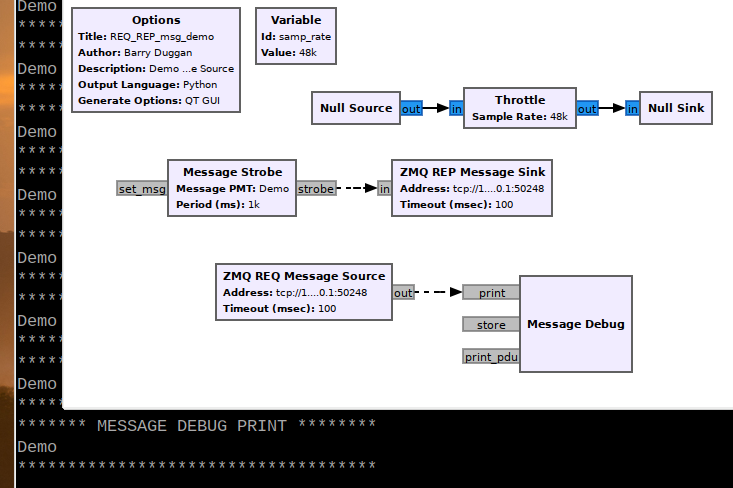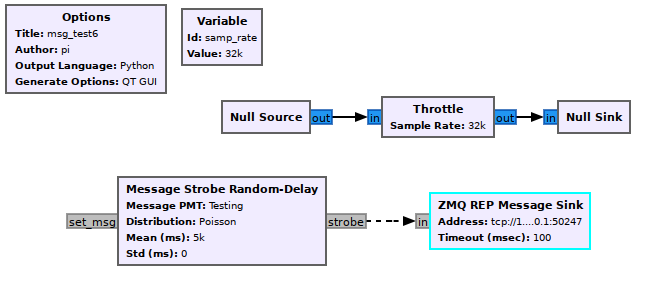ZMQ REP Message Sink: Difference between revisions
(add example flowgraph) |
(add note about IP addresses) |
||
| (4 intermediate revisions by the same user not shown) | |||
| Line 1: | Line 1: | ||
[[Category:Block Docs]] | [[Category:Block Docs]] | ||
The ZMQ REP Message Sink block receives async messages and sends them to a ZMQ REP socket. This block will connect to a ZMQ REQ Message Source < | The ZMQ REP Message Sink block receives async messages and sends them to a ZMQ REP socket. This block will connect to a ZMQ REQ Message Source.<br> | ||
The zeromq.org website says:<br> | |||
"The REQ-REP socket pair is in lockstep. The client issues zmq_send() and then zmq_recv(), in a loop (or once if that's all it needs). Doing any other sequence (e.g., sending two messages in a row) will result in a return code of -1 from the send or recv call." Likewise, the server "issues zmq_recv() and then zmq_send() in that order, as often as it needs to."<br> | |||
== Parameters == | == Parameters == | ||
| Line 7: | Line 9: | ||
; Address | ; Address | ||
: ZMQ socket address specifier. The format of the address is <code>tcp://*:port</code> where * should be 127.0.0.1 for localhost.<br> | : ZMQ socket address specifier. The format of the address is <code>tcp://*:port</code> where * should be 127.0.0.1 for localhost.<br> | ||
: <b>Note:</b> If the Source and Sink blocks are on two different computers on the same LAN, then the IP and port number of the Sink block must be specified on each end of that connection. For example, if the Sink is on IP 192.168.2.14:5678 and the Source is on IP 192.168.2.5, both Source and Sink blocks must specify the Sink IP and port (192.168.2.14:5678). | |||
; Timeout | ; Timeout | ||
| Line 12: | Line 15: | ||
== Example Flowgraph == | == Example Flowgraph == | ||
=== Inter-flowgraph === | |||
Request/Reply pairs can be used on one, or two separate, flowgraphs to exchange messages.<br> | |||
[[File:REQ_REP_msg_demo_fg.png]] | [[File:REQ_REP_msg_demo_fg.png]] | ||
=== External Python client (receive only) === | |||
An external Python program can receive messages from a ZMQ REP Message Sink block. An example flowgraph and Python code follow.<br> | |||
[[File:Msg_test6_fg.png]] | |||
The Python client code looks like this:<br> | |||
<pre> | |||
#!/usr/bin/env python3 | |||
# -*- coding: utf-8 -*- | |||
# The REQest / REPly nomenclature of the GNU Radio message blocks is from | |||
# the perspective of the flowgraph. So, to send a 'request' to GNU Radio, the message | |||
# must be sent as a 'reply' from the Python client, Likewise, a 'reply' from GNU Radio | |||
# must be received as a 'request' to the Python client! Therefore, send on the reply socket | |||
# and receive on the request socket. | |||
# | |||
# The zeromq.org website says: | |||
# "The REQ-REP socket pair is in lockstep. The client issues zmq_send() and then zmq_recv(), | |||
# in a loop (or once if that's all it needs). Doing any other sequence (e.g., sending two messages in a row) | |||
# will result in a return code of -1 from the send or recv call." Likewise, the server "issues zmq_recv() | |||
# and then zmq_send() in that order, as often as it needs to." | |||
# | |||
# To conform to that requirement, a non-standard "kludge" is used (see below). | |||
import zmq | |||
import pmt | |||
def main(): | |||
zmq_context = zmq.Context() | |||
zmq_sock = zmq_context.socket(zmq.REQ) | |||
zmq_sock.connect("tcp://127.0.0.1:50247") | |||
while(True): | |||
zmq_sock.send_string("\x01\x00\x00\x00") # this is the non-standard "kludge" | |||
msg = zmq_sock.recv() | |||
print (pmt.to_python(pmt.deserialize_str(msg))) | |||
if __name__ == '__main__': | |||
main() | |||
</pre> | |||
=== GNU Radio as a server === | |||
If the GNU Radio flowgraph(s) is configured as a server, the REQ message is processed by the flowgraph and a message is sent back in a REP message as the response. See [[ZMQ_REQ_Message_Source#GNU_Radio_as_a_server]] for details. | |||
== Source Files == | == Source Files == | ||
Latest revision as of 15:25, 26 March 2020
The ZMQ REP Message Sink block receives async messages and sends them to a ZMQ REP socket. This block will connect to a ZMQ REQ Message Source.
The zeromq.org website says:
"The REQ-REP socket pair is in lockstep. The client issues zmq_send() and then zmq_recv(), in a loop (or once if that's all it needs). Doing any other sequence (e.g., sending two messages in a row) will result in a return code of -1 from the send or recv call." Likewise, the server "issues zmq_recv() and then zmq_send() in that order, as often as it needs to."
Parameters
(R): Run-time adjustable
- Address
- ZMQ socket address specifier. The format of the address is
tcp://*:portwhere * should be 127.0.0.1 for localhost. - Note: If the Source and Sink blocks are on two different computers on the same LAN, then the IP and port number of the Sink block must be specified on each end of that connection. For example, if the Sink is on IP 192.168.2.14:5678 and the Source is on IP 192.168.2.5, both Source and Sink blocks must specify the Sink IP and port (192.168.2.14:5678).
- Timeout
- Socket timeout in milliseconds, default is 100ms.
Example Flowgraph
Inter-flowgraph
Request/Reply pairs can be used on one, or two separate, flowgraphs to exchange messages.
External Python client (receive only)
An external Python program can receive messages from a ZMQ REP Message Sink block. An example flowgraph and Python code follow.
The Python client code looks like this:
#!/usr/bin/env python3
# -*- coding: utf-8 -*-
# The REQest / REPly nomenclature of the GNU Radio message blocks is from
# the perspective of the flowgraph. So, to send a 'request' to GNU Radio, the message
# must be sent as a 'reply' from the Python client, Likewise, a 'reply' from GNU Radio
# must be received as a 'request' to the Python client! Therefore, send on the reply socket
# and receive on the request socket.
#
# The zeromq.org website says:
# "The REQ-REP socket pair is in lockstep. The client issues zmq_send() and then zmq_recv(),
# in a loop (or once if that's all it needs). Doing any other sequence (e.g., sending two messages in a row)
# will result in a return code of -1 from the send or recv call." Likewise, the server "issues zmq_recv()
# and then zmq_send() in that order, as often as it needs to."
#
# To conform to that requirement, a non-standard "kludge" is used (see below).
import zmq
import pmt
def main():
zmq_context = zmq.Context()
zmq_sock = zmq_context.socket(zmq.REQ)
zmq_sock.connect("tcp://127.0.0.1:50247")
while(True):
zmq_sock.send_string("\x01\x00\x00\x00") # this is the non-standard "kludge"
msg = zmq_sock.recv()
print (pmt.to_python(pmt.deserialize_str(msg)))
if __name__ == '__main__':
main()
GNU Radio as a server
If the GNU Radio flowgraph(s) is configured as a server, the REQ message is processed by the flowgraph and a message is sent back in a REP message as the response. See ZMQ_REQ_Message_Source#GNU_Radio_as_a_server for details.
Source Files
- C++ files
- TODO
- Header files
- TODO
- Public header files
- TODO
- Block definition
- TODO

